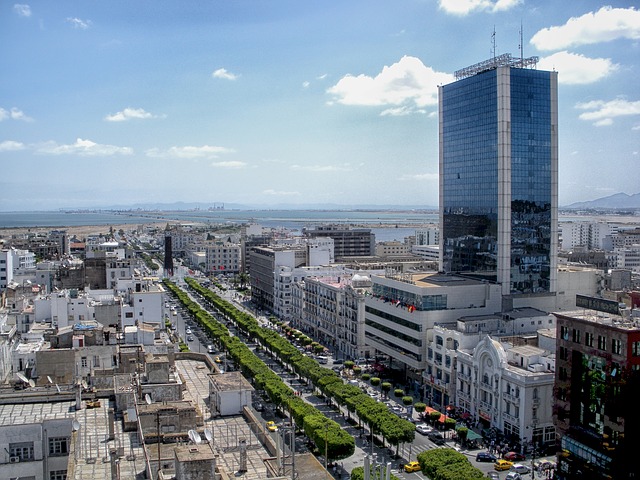By Tim Lambert
Ancient Tunisia
By about 8,000 BC human beings lived in what is now Tunisia by hunting and gathering. After about 5,000 BC they began farming although they still used stone tools. Then from about 1100 BC the Phoenicians from what is now Lebanon settled and traded in the area.
About 480 BC the Phoenicians founded Carthage. Slowly this city became stronger. In time the Carthaginians built an empire in the Mediterranean.
However, they came into conflict with Rome. The First Punic War between Carthage and Rome began in 263 BC and lasted until 241 BC. It ended in the Carthaginian defeat. A second war followed in 218 BC. This time Hannibal led an army across the Alps into Italy but he failed to capture Rome. Finally, in 202 the Carthaginians were crushed by the Romans at the Battle of Zama.
A third was fought between 149 and 146 BC. This time Carthage was destroyed. However, the Romans later rebuilt Carthage as a Roman city.
Under Roman rule, Tunisia prospered and it exported grain and olive oil to other parts of the empire. Furthermore, many Romans settled in the area and trade flourished.
However, by the 5th century, the Roman Empire was crumbling. A people called the Vandals had conquered Spain. In 429 80,000 Vandals led by Genseric crossed to North Africa. In 439 they captured Carthage and created a new kingdom. Meanwhile, the Roman Empire had split into 2 halves, East and West. The Eastern half became known as the Byzantine Empire. In 533 Byzantine Emperor Justinian sent an army under his general Belisarius, which crushed the Vandals and took Carthage.
Medieval Tunisia
Byzantine rule in Tunisia lasted till 698. In that year the Arabs took Carthage. At first, Arab Tunisia was ruled by the Caliphs but in 800 Ibrahim ibn al Aghlab was made hereditary ruler of the country. Under the Aghlabid dynasty, Tunisia prospered and trade flourished.
Nevertheless, in 909 a strict sect called the Ismailis led a rebellion and ousted the Aghlabids. The leader of the Ismailis took over Tunisia. He claimed to be descended from Muhammad’s daughter Fatima so his dynasty was called Fatimids.
In 921 the Fatimids founded Mahida, which became the capital. Then in 969, the Fatimids captured Egypt, and shortly afterward they made Cairo their new capital. From then on Tunisia was ruled by a semi-independent dynasty of governors called the Zirids. However, the Zirids broke away from the Fatimids and became completely independent in 1049. For revenge, the Fatimids persuaded two Bedouin tribes, the Banu Hilal and Banu Sulaym to attack the Zirids.
Furthermore, in the 12th century, the Normans (who ruled Sicily) captured most of the Tunisian ports. They captured Jerba in 1135 and Mahdia in 1148. However, the Almohads who came from Morocco drove them out. The Almohads captured Tunis in 1159.
However, in 1229 the governor in Tunisia broke away and formed a new dynasty. The Hafsids succeeded in restoring order to Tunisia. During the thirteenth century, Tunisia prospered and trade flourished. n Modern Tunisia
In 1574 Tunisia was conquered by the Ottoman Turks. During the 17th, 18th, and early 19th centuries many Tunisians were pirates. They were called Barbary pirates. (The word Barbary is derived from Berber). From time to time European powers took action against the Barbary pirates. (e.g. In 1655 the English Admiral Blake bombarded Porto Farina). The Europeans also extorted various treaties none of which ended the piracy.
Turkish rule in Tunisia ended in 1705 when Hussain Ibn Ali began the Hussainid dynasty.
Modern Tunisia
Then during the 19th century, European, especially Italian influence increased in Tunisia. When Tunisia went bankrupt in 1869 Britain, France, and Italy took control of Tunisian finances. Then in 1881 French troops entered from Algeria and forced the Tunisian bey to accept a French protectorate.
Tunisian nationalism soon grew and in the early 20th century an independence movement was formed. Then in 1940 when Germany conquered France Tunisia came under the French Vichy government. The Germans occupied Tunisia in November 1942 but their troops surrendered to the Allies in May 1943.
After the Second World War Tunisians continued to agitate for freedom. Finally, on 20 March 1956, France agreed to Tunisian independence. The first election was held on 25 March 1956. At first, Tunisia was a constitutional monarchy but in 1957 it became a republic.
Habib Bourguiba became the first president. In 1975 he was made president for life but in 1987 he was removed from power and was replaced by Zine El Abidine Ben Ali.
Meanwhile, oil was discovered in Tunisia in 1964 while in international affairs Tunisia adopted a non-aligned stance.
However, in 2011, there was unrest in Tunisia in 2011 and Ben Ali was forced to flee. A new chapter in the history of Tunisia began. Elections were held in Tunisia in October 2011. a new constitution was adopted in 2014.
Today the Tunisian economy is growing and poverty is declining rapidly. Tunisia is becoming more and more prosperous. Tourism is an important industry. In 2024 the population of Tunisia was 12 million.

Tunis
Last Revised 2025